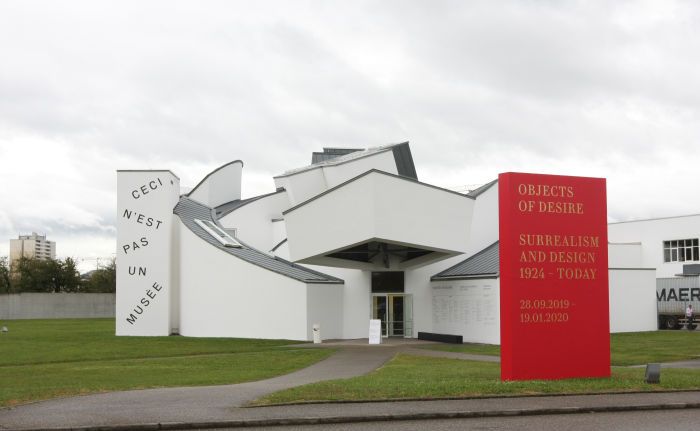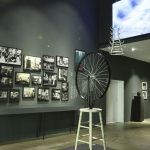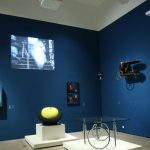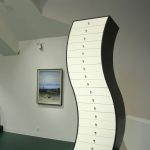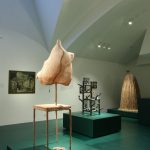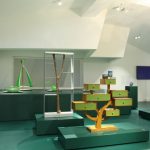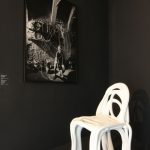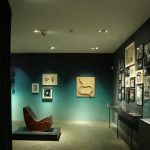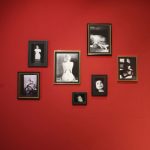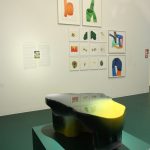Objects of Desire. Surrealism and Design 1924 – Today @ The Vitra Design Museum, Weil am Rhein
“After you have settled yourself in a place as favorable as possible to the concentration of your mind upon itself, have writing materials brought to you”, so begins Secrets of the Magical Surrealist Art – Written surrealist composition, part of André Breton’s 1924 Surrealist Manifesto, “Put yourself in as passive, or receptive, a state of mind as you can. Forget about your genius, your talents, and the talents of everyone else. Keep reminding yourself that literature is one of the saddest roads that leads to everything. Write quickly, without any preconceived subject, fast enough so that you will not remember what you’re writing and be tempted to reread what you have written. The first sentence will come spontaneously, so compelling is the truth that with every passing second there is a sentence unknown to our consciousness which is only crying out to be heard.”1
Ready? Here goes, a Surrealist, automatic, blog post……………….
….no, not really.
Although we did consider it, as in genuinely, seriously, hired staff to bring us our writing materials and everything; but we did and do have a preconceived subject: the exhibition Objects of Desire. Surrealism and Design 1924 – Today at the Vitra Design Museum.
And so with apologies to André Breton and his Surrealist cohorts, we’ll consider their work and their influence on/interaction with design at our accustomed tempo, and with regular re-readings, re-formulations and very conscious re-framings……
As we all know design can’t develop and evolve, doesn’t exist, independently; rather, design is intimately linked with, influenced by, and informed through both wider political, economic, technological, cultural, environmental, et al developments and also evolutions and developments in other creative expressions, primarily evolutions and developments in art: an interplay the Vitra Design Museum explored in their 2012 exhibition Pop Art Design in context of, well, Pop Art and Pop Design and which Objects of Desire explores in context of design and that most singular of artistic expressions, Surrealism.
Following a brief pre-history in the years immediately following the cessation of the First World War, the story of Surrealism formally, if one can use such a term in such a context, begins in Paris 1924 with the publication of the Surrealist Manifesto…. OK technically with two Surrealist Manifestos published in 1924 in Paris, that by Yvan Goll however playing a secondary role in the development and (hi)story of Surrealism to that published by André Breton, a work which came to be the official Surrealist Manifesto and which defined Surrealism as “Psychic automatism in its pure state, by which one proposes to express – verbally, by means of the written word, or in any other manner – the actual functioning of thought. Dictated by the thought, in the absence of any control exercised by reason, exempt from any aesthetic or moral concern.”
As an exhibition Objects of Desire helps you approach an understanding of what that means in practice, both art practice and design practice…….
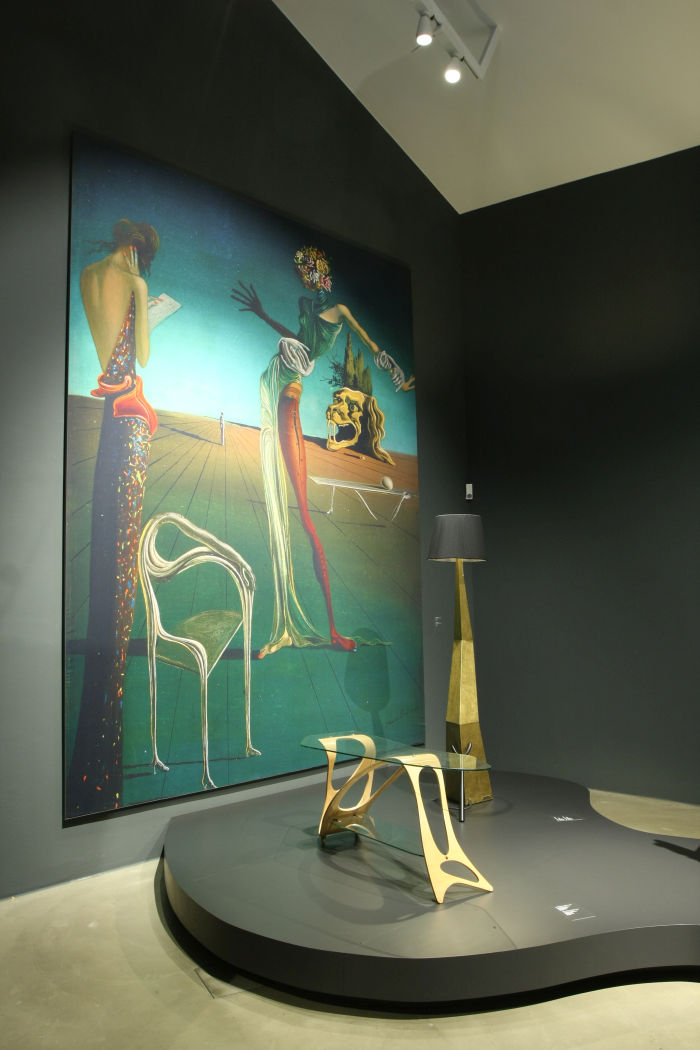
A blow-up of the painting Femme à la tête de roses by Salvador Dalí alongside Arabesco by Carlo Mollino and the lamp Bracelli by Salvador Dalí, as seen at Objects of Desire. Surrealism and Design 1924 – Today, Vitra Design Museum
That Surrealism is today most popularly represented and understood through painting and sculpture, one could be, and many are, excused for believing it was always about painting and sculpture. It wasn’t. Much more Surrealism was conceived as a primarily literary form of reaction, expression, protest, indeed much of the Preface to the Surrealist Manifesto is taking up with criticism of late 19th/early 20th century literature, including, we suspect, a few underhand digs at Émile Zola. The more visual approach to Surrealism however arose and established itself very quickly; and it is such visual representations that Objects of Desire primarily employs in its opening chapter as a means by which to explain Surrealism, the origins, ideas of Surrealism and the expression of Surrealism in the period until ca. 1950, if you will the first flush of Surrealism. Visual representations including photos of Surrealist interiors, impressions from Surrealist exhibitions, examples of Surrealist texts and also early works of Surrealist art and Surrealist inspired design by the likes of Man Ray, Marcel Duchamp, Salvador Dalí or Le Corbusier, who had moved to Paris in 1917, and thus in the very early days of pre-history Surrealism, and who in 1918, along with Amédée Ozenfant, published Après le Cubisme – After Cubism – as their proposition for new directions for artistic expression. Surrealism is also a post-cubisme path, and while the path Le Corbusier ultimately took may not have been Surrealist, as Objects of Desire helps explain, it was a path influenced and informed by Surrealism.
In addition the opening chapter follows Surrealism as it crossed the Atlantic to America, a route it took via many means, not least the war time emigration of many European protagonists, and also through the person of Peggy Guggenheim, a not unimportant personality in the development of 20th century art understandings in America, and a gallerist, who, in many regards, developed her own understandings of art in 1920s and 1930s Paris where she spent many years moving amongst, and exhibiting works by, the Surrealists, and who personally helped André Breton flee to America from the approaching Nazis.
Alongside photos of Surrealists and Surrealists’ work in America, Objects of Desire also features examples of early American Surrealist informed design, including a chess table Isamu Noguchi created for the 1944/45 exhibition The Imagery of Chess, curated at the Julien Levy Gallery, New York, by Marcel Duchamp and Max Ernst, and also a moulded walnut plywood sculpture from 1943 by Ray Eames. And thus a sculpture from a period when the Eames’s were commercially producing all manner of functional objects from moulded plywood, and by an artist who, lest we forget, studied under Hans Hofmann, a German émigrée abstract expressionist who developed approaches to creating art informed by the automatism of Surrealism; and thus that Ray Eames’ early training was closely, though not exclusively, informed by Surrealist thought. Considerations which allow one to view many of the works in the Eames canon through new, Surrealist, eyes.
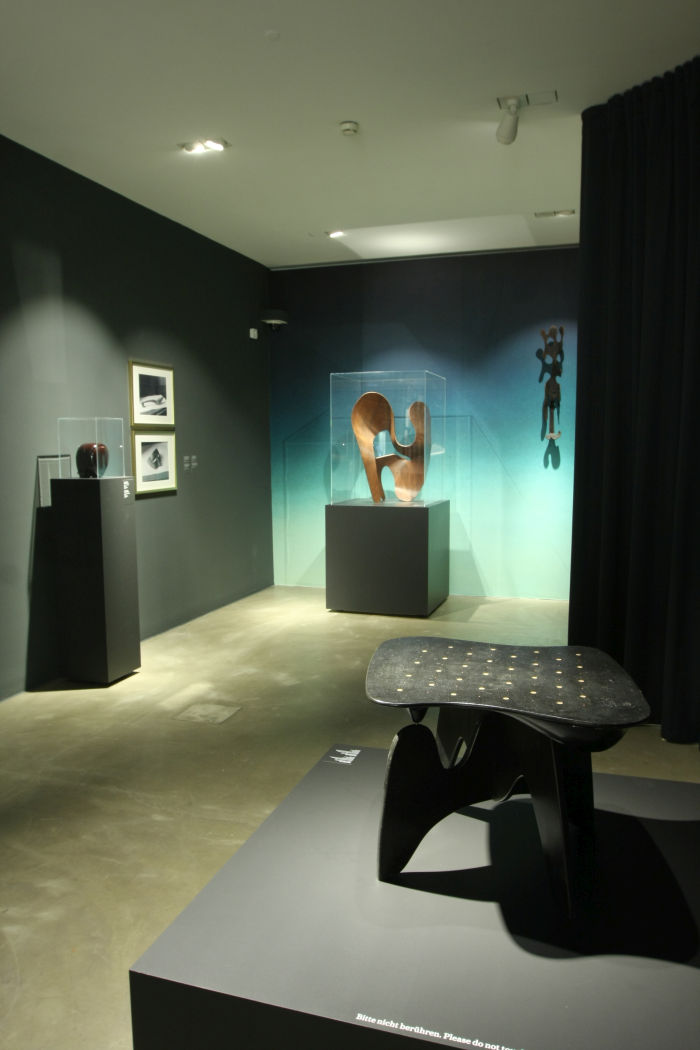
Works by Isamu Noguchi and Ray Eames, as seen at Objects of Desire. Surrealism and Design 1924 – Today, Vitra Design Museum
Having introduced Surrealism, Objects of Desire moves on to discuss Surrealism, design, Surrealism and design in three, relatively, wide contexts starting with Image and Archetype in which the curators discuss and explore how Surrealists corrupt, alienate, subvert, re-imagine, re-position everyday objects. In context of the exhibition Mon univers at the Pavillon Le Corbusier Zürich we opined how the numerous archetypal objects found in Le Corbusier’s collection “remind us, and one presumes reminded Le Corbusier, that the form/function relationship is very simple and once established needn’t be all to deeply reconsidered.” Which we thought was a pretty safe, uncontroversial, sentence.
However, not only does Objects of Desire make clear that Le Corbusier didn’t, or didn’t exclusively, follow such a unequivocal form/function relationship, but makes equally clear, that the Surrealists firmly rejected such a position and developed a strong hang to using archetypes firmly out of context, to fundamentally questioning not only the form/function relationship but also the very essence, meaning, of function. And also helps make clear that exempting aesthetic concerns from your thoughts needn’t lead to unaesthetic results; clarities expressed through Surrealist inspired design such as, and amongst many other works, Le Témoin by Man Ray – an oversized eye as a seating element, Hand Chair by Pedro Friedeberg, a well, hand as a chair, Meret Oppenheim’s Traccia table with its crow legs base and foot print decor, or Studio65’s Capitello, an ionic capital appropriated as a lounge chair, and a work which is one of several in Objects of Desire which also appeared in Pop Art Design, a continuity that underscores the ever rotating helix on which we find ourselves.
And also underscores the Readymade and bricolage as design.
In the introductory chapter one finds Duchamp’s Roue de bicyclette, a bicycle wheel atop a wooden stool, or his Bottle Rack, in Image and Archetype one finds works works such as, an amongst others, Achille and Pier Giacomo Castiglioni’s Sella stool, a bicycle seat atop a single pole stand or Gae Aulenti’s Tour table with a functioning bicycle wheel at each corner for mobility; and thus a presentation that helps explain how short, direct, the path between art and design is/can be. And how many designers make that short, direct, trip by bicycle. And thus, yes, also reminds us, once again, of Jasper Morrison’s 1984 text The Poet will not Polish: “Marcel Breuer seeing a pair of bicycle handle-bars decided to make chairs using the same industrial process. The new world constructor seeing a pair of bicycle handle-bars decides to use them as they are and save himself the trouble and expense of bending the tube.”2 A text written at a time when Morrison was living and working in West Berlin, and producing numerous Readymades and post-industrial bricolage works; works arguably inspired by the Postmodern Neue deutsche Design environment he was moving in, and which thus underscores some of the connections between Surrealism and Postmodernism, but arguably also inspired from the fact that as he told us in context of his own Thingness exhibition, Surrealism played a role in his creative development, “while I was studying design at Kingston I had a small sideline as a second-hand book dealer and was particularly focussed on surrealism and Dada, as well as architecture and design.”
The Surreal developing for Le Corbusier to Brutalism, for Ray Eames to American Midcentury Modernism and for Jasper Morrison to the Super Normal.
Same same, but different.
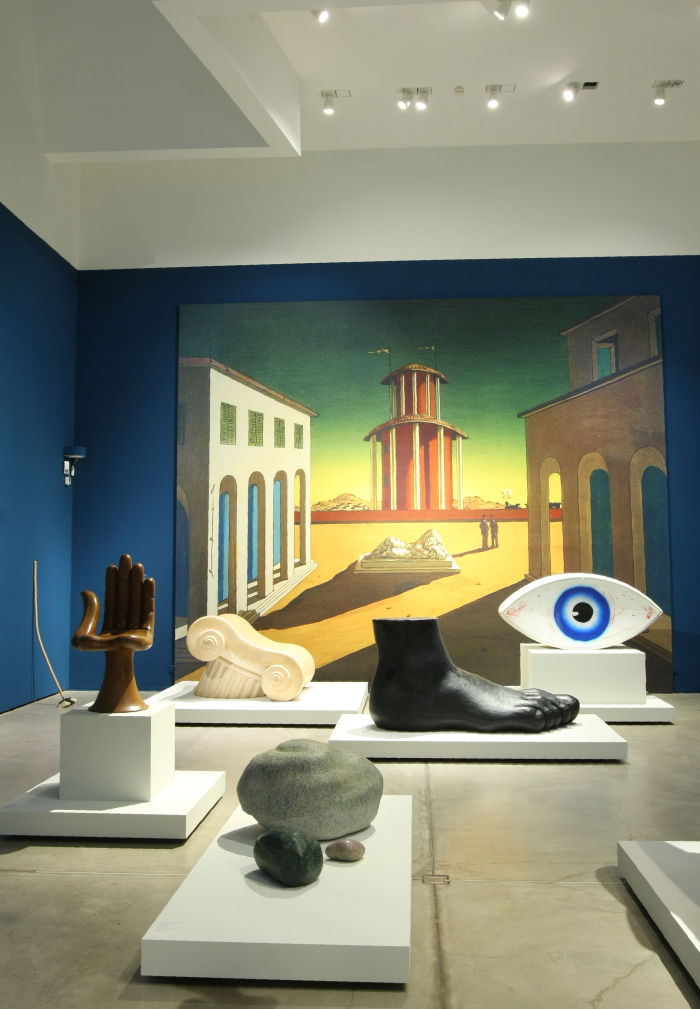
Image and Archetype, as seen at Objects of Desire. Surrealism and Design 1924 – Today, Vitra Design Museum
In addition to corruption and alienation a further central characteristic of much Surrealism is and was a very potent sense of sexuality, eroticism, and of a sexual deviancy, if you will a corruption and alienation exempt of any “moral concern”. Certainly George Orwell was firmly of the opinion that Salvador Dalí “seems to have as good an outfit of perversions as anyone could wish for”, and that the two defining features of his paintings and photography are “sexual perversity and necrophilia”3,4; and as Objects of Desire explains that sexual desire as expressed by Surrealists was often far removed from that which as Kate Tempest so eloquently describes, “compels without force”, there is a darkness and misogyny in a lot of Surrealist sexuality.
Amongst the works through which Objects of Desire discusses Surrealism influenced eroticism in design is a 1:5 scale model of Gaetano Pesce’s UP5 & UP6 armchair and ottoman, a stylised female torso as a lounge chair, the round ottoman attached via a chain, a work which, as previously noted, Pesce argues, and which we believe, is a critical reflection on the role, position and situation of females in contemporary 1960s (Italian) society, but which others see very much as an objectification, of a reduction of the female to a purely, primarily, sexual object. The model presented in Objects of Desire, with its deep-cut, cleavage exposing, dress upholstery making a much more dramatic visual impression than the conservative one allowed by the neutral monotone upholstery of the B&B Italia version. And thereby only extending the equivocality of the interpretation.
Much less equivocal, if an object that still allows the faintest of margins for positive spin, is Allen Jones’ 1969 Chair, a work which lays a hot pant, stilettoed boot wearing female mannequin on her back on a sheepskin rug, and places the seat on the underside of her raised, and bondaged, thighs; and a work countered in Objects of Desire by Man Chair by Ruth Francken which transforms a squatting male form into a chair, thereby placing the male very much as the bondaged, dominated, in the relationship, and thus a work which reflects a more feminist Surrealist inspired position. And which thus raises wider questions about feminist resistance and feminist expression in Surrealist art. And while we’re on such gender considerations, the chapter Images and Archetypes also features the ever magnificent Horse Lamp by Front: a full-size plastic horse with a lamp on its head. In all the years we’ve been enjoying and delighting in Horse Lamp we never noticed it was a boy horse; if Front meant to imply males are the enlightened ones, we know no. But we can’t imagine they did. Or is it ironic…..?
The final section explores more contemporary interpretations and expressions of Surrealism in design, one could argue works which explore the legacy of Breton’s 1924 Manifesto, how it has evolved, developed and responded to changing social and cultural realities; and which, to judge by the works on show in Objects of Desire has primarily been an evolution and development informed by natural, environmental realities, and as expressed by the likes of Nacho Carbonell in his Table Cocoon 8, Andrea Branzi’s Piccolo Albero, and also by objects from Designs for an Overpopulated Planet: Foragers by Dunne & Raby, a project concerned with feeding an ever growing population in an ever less stable ecosystem, a project we last encountered at Food Revolution 5.0. Design for Tomorrow’s Society at the Museum für Kunst und Gewerbe Hamburg, and a project which tends to indicate that it is the continuing, evolving, legacy of Surrealism that is in many regards the most important and interesting aspect in context of Surrealism and design. Important and critical as Surrealism and Design 1924 – Today, is and was, Surrealism and Design Still to be Dreamed, is, we’d argue, much more important and critical.
But to argue that, we first we need to go back to 1924.
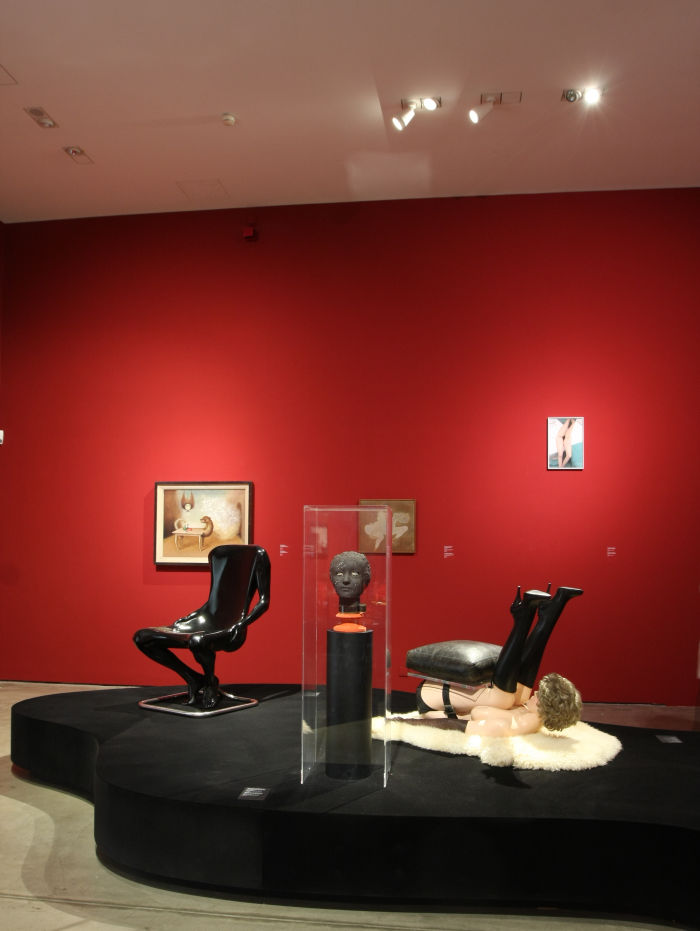
Man Chair by Ruth Francken (l) & Chair by Allen Jones (r), as seen at Objects of Desire. Surrealism and Design 1924 – Today, Vitra Design Museum
Surrealism arose parallel to inter-War Modernism, and it is arguably not irrelevant in the (hi)story of things that André Berton’s Manifesto was published shortly after the 1923 Bauhaus Weimar exhibition which (more or less) signified the school’s (still relatively infant) move from craft to industry, shortly after the publication of Le Corbusier’s Vers une Architecture which collated numerous texts by Le Corbusier on the future of architecture, including the infamous claim, La maison est une machine à habiter, The house is a living machine, and was also published just before the Neues Frankfurt project was formally initiated in 1925; and thus in that inter-War phase when the functionalism, rationalism and industrialisation of Modernism was becoming increasingly prevalent. And also when, for example, as discussed from Time, Freedom and Control – The Legacy of Johannes Bürk at the Uhrenindustriemuseum Villingen-Schwenningen, the inter-War Modernists were increasingly developing a consciously Taylorist optimising of society. A state of affairs which meant design decisions were increasingly focussed on the functionality of an object, and the functionality alone, or as Breton opined, “the desire for analysis wins out over feeling”5
And how does one regain feeling?
Alvar Aalto choose to employ birch plywood as a means of humanising the industrial, cold, metallic of modernism.
Surrealism choose the non-rational and subconscious, arguing, “if the depths of our mind contain within it strange forces capable of augmenting those on the surface, or of waging a victorious battle against them, there is every reason to seize them.”
And an approach to which Sigmund Freud played a not inconsiderable role, Breton thanking him in his Manifesto for his discoveries, adding that on account of Freud’s work “a current of opinion is finally forming by means of which the human explorer will be able to carry his investigation much further, authorized as he will henceforth be not to confine himself solely to the most summary realities. The imagination is perhaps on the point of reasserting itself, of reclaiming its rights.”
Thereby making Surrealism the second movement, if that is the correct phrase, in which the psychoanalysis and unconscious of Sigmund Freud played a key role, for as we all learned from the Museum für Kunst und Gewerbe Hamburg’s 2015 exhibition Art Nouveau. The Great Utopian Vision, Freud’s writings and research were important in the development of the late 19th century reformist thinking that flowed into Art Nouveau.
And on reflection, the differences aren’t as radical as you might think, Orwell for example noting that Dalí claimed to have “an especial affection for the year 1900”, and arguing that when viewing Dalí’s work, “take away the skulls, ants, lobsters, telephones and other paraphernalia, and every now and again you are back in the world of Barrie, Rackham, Dunsany and Where the Rainbow Ends.”6 Back in the world of late 19th/early 20th century fairy-tales, fantasy and imagination. And a world in which much Surrealist art would, arguably, feel, when not at home then certainly very comfortable.
And thus one could argue that whereas the Modernists continued with the rationalisation of form, materials, construction and production begun by the Art Nouveauists, the Surrealists continued the fascination with Freudian thinking, be that the hidden worlds of the subconscious and dream or the Eros and Thanatos that Objects of Desire argues underscores the sexuality, both light and dark, that is such a central characteristic of much Surrealism.
Or put another way, faced with the questions of a future society posed in the wake of the First World War and the associated political, economic and social upheaval, the Modernists employed the rational, analytical and conscious: the Surrealist asked “Can’t the dream also be used in solving the fundamental questions of life?”
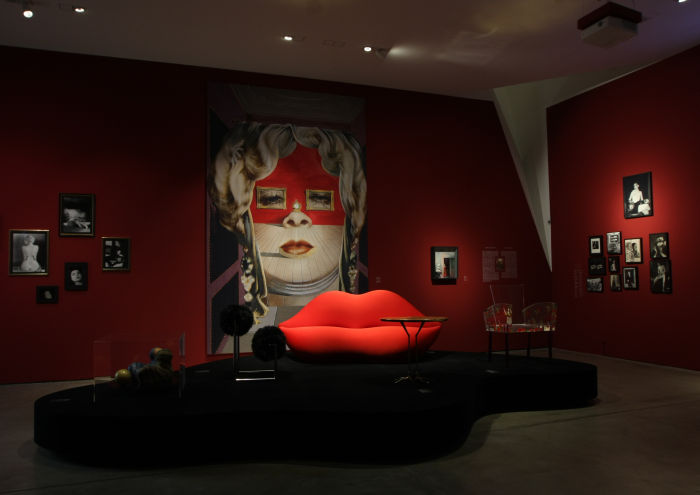
Mae West’s Face which May be Used as a Surrealist Apartment by Salvador Dalí and Marilyn/Bocca by Studio65 for Gufram, as seen at Objects of Desire. Surrealism and Design 1924 – Today, Vitra Design Museum
By way of applying the dream, the unconscious, in their work, Surrealists actively sought to take human thought out of creativity, created automated, independent, arbitrary processes in which the conscious mind played as little a role as possible, and celebrated uncertainty, randomness, the existent and the “superior reality of certain forms of previously neglected associations.”
And therefore while contemporary creatives can, and do, learn directly from rejecting the considered and analytical in their work and trusting more in Surrealist randomness and subconscious, much more important for contemporary, and future, design, for us the most important legacy of Surrealism, and an important message from Objects of Desire, is the understanding that Surrealism wasn’t developed as a rigid, inflexible aesthetic, but was essentially about developing new creative processes, about considering the how/why/wherefore of what one did, considering if your approach to an answer didn’t complicate the question, considering alternative strategies, of freeing the mind from conventions, norms, rationality and history, of accepting the “truth that with every passing second there is a sentence unknown to our consciousness which is only crying out to be heard”. Of thinking outside the box, or perhaps more accurately, of thinking in the hidden, subconscious, depths of the box everyone else thinks within.
There is a position, to which we have a long-term subscription, that amongst the creative expressions design alone can actively change the world. Art, theatre, music, literature et al can comment, can rebel, can enable reflection, can challenge convention, can motivate, inspire, be a force for change: but only design can actively change things on its own.
And if we consider Surrealism as a framework within which to develop new processes, then that means Surrealism can actively change the world. And that makes Surrealism design? We’d argue, no. But nor does it make it art. Nor does it make it an interface between art and design. Much more it makes Surrealism a tool, a segue between the probable and possible, a conduit via which the possible and probable can communicate, a portal through which the probable and possible can become one. That Surrealism is an approach, a methodology, and one which, for André Breton et al, has the power to “to ruin once and for all all other psychic mechanisms and to substitute itself for them in solving all the principal problems of life.”
And while wouldn’t necessarily want to ruin all other mechanisms, as Objects of Desire pleasingly explains, once adopted Surrealism can be very potent, fruitful and rewarding ally.
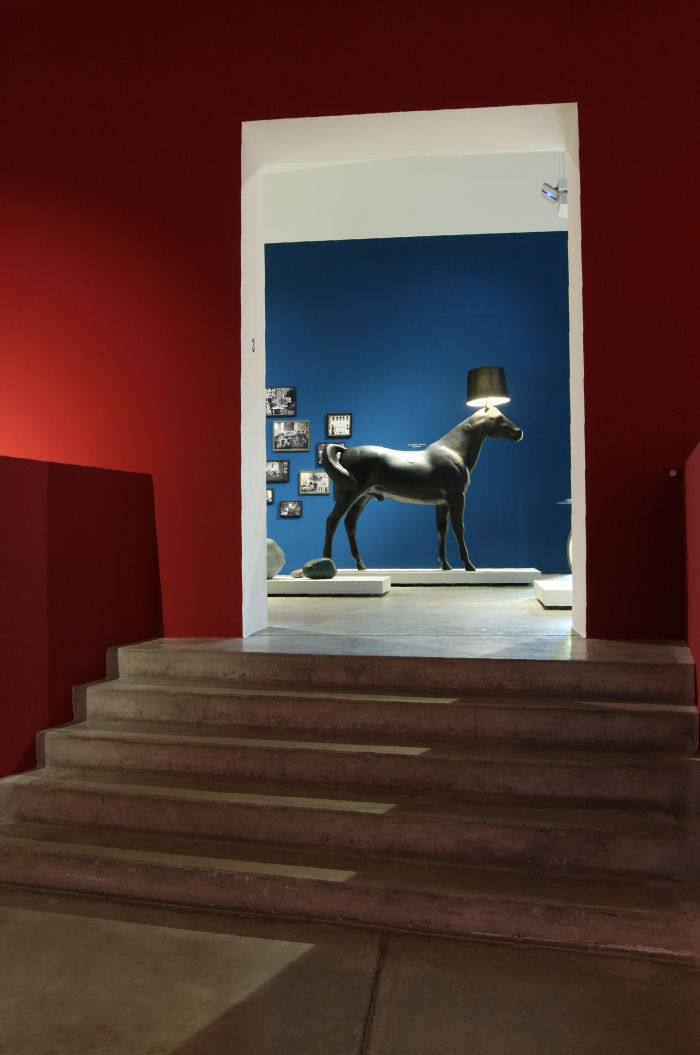
Horse Lamp by Front for moooi, as seen at Objects of Desire. Surrealism and Design 1924 – Today, Vitra Design Museum
Thankfully avoiding any temptation to create a psychedelic, dreamscape, scenography, Objects of Desire instead treats the objects strictly rationally, setting design objects alongside film, photographs, books, clothing and works of surrealist and pre-surrealists art by the likes of, and amongst many others, René Magritte, Salvador Dalí, Yves Tanguy or Giorgio de Chirico and therefore allows the assembled objects to dictate the story as it unfolds; ably supported as they do by clear, concise, comprehensible scene-setting texts. In no way a full, all-inclusive, survey of Surrealism, but them it doesn’t set out to be, Objects of Desire does however provide for both an accessible introduction to Surrealism and an equally approachable discussion on the interplay between art and design in a Surrealist context, while also providing ample impetus for further study on your own.
And also allows for some new reflections on the development of design, of the path design has taken since the late 19th century, a path normally followed from a Modernist perspective, but which as Objects of Desire neatly, and convincingly, explains can, must, be explored in its fuller vitality, that moments such as Pop Art, Italian Radicalism, Postmodernism, et al owe a debt as large to Surrealism as they do to Modernism. Or perhaps better put, to an embracing of Surrealism as much as to a rejection of Modernism.
And thereby also underscores that Surrealism can, should, be considered as a contrary position to the Modernist ethos, that Surrealism represents an alternative approach to the challenges of the 1920s, and to then posed questions of society’s future direction, questions whose answer André Breton sought in a very specific location: “I believe in the future resolution of these two states, dream and reality, which are seemingly so contradictory, into a kind of absolute reality, a surreality, if one may so speak. It is in quest of this surreality that I am going, certain not to find it but too unmindful of my death not to calculate to some slight degree the joys of its possession.”
Objects of Desire allows us all, to some slight degree, to share, the joys, and horrors, of its possession.
Objects of Desire Surrealism and Design 1924 – Today runs at the Vitra Design Museum, Charles-Eames-Str. 2, 79576 Weil am Rhein until Sunday January 19th
Full details, including information on the accompanying fringe programme, can be found at www.design-museum.de/objects-of-desire
1. and all further quotes unless otherwise stated, André Breton, Manifesto of Surrealism (1924) http://www.ubu.com/papers/breton_surrealism_manifesto.html Accessed 01.10.2019 An unattributed translation, but one we like, and one which the MoMA New York link to and so which we feel confident using.
2. Jasper Morrison, The Poet Will Not Polish, in Kaufhaus des Ostens, Catalogue, c kdo + verlag zweitschrift, Hannover 1984
3. George Orwell, Benefit of Clergy: Some Notes on Salvador Dalí, 1944, in George Orwell Essays, Penguin Books 2000
4. In the interests of completion, and fairness, Orwell also considers Dalí an accomplished and talented artist, as in technically accomplished and talented, or as he put it, “a good draughtsman and a disgusting human being”, and the central tenet of the text is the conflict between the character of an artist and our assessment of their work, as discussed through Dalí.
5. The context is slightly wrong, but we feel confident in the transposition
3. George Orwell, Benefit of Clergy: Some Notes on Salvador Dalí, 1944, in George Orwell Essays, Penguin Books 2000
- Roue de bicyclette and Bottle Rack by Marcel Duchamp, as seen at Objects of Desire. Surrealism and Design 1924 – Today, Vitra Design Museum
- MAgrTTA by Roberto Sebastian & Matta Echaurren, Tour by Gae Aulenti & La Pipa by Aldo Tura , as seen at Objects of Desire. Surrealism and Design 1924 – Today, Vitra Design Museum
- Side 1 by Shiro Kuramata and La splendour semblable by Yves Tanguy, as seen at Objects of Desire. Surrealism and Design 1924 – Today, Vitra Design Museum
- Cocoon 8 by Nacho Carbonell, An Uncomfortable Place by Alberto de Braud & Cabana by Fernando & Humberto Campana, as seen at Objects of Desire. Surrealism and Design 1924 – Today, Vitra Design Museum
- Designs for an Overpopulated Planet: Foragers by Dunne Raby, Piccolo Albero by Andrea Branzi, Arbre à tiroirs by Marcel Jean & Syntopia Look 7 by Iris van Herpen, as seen at Objects of Desire. Surrealism and Design 1924 – Today, Vitra Design Museum
- Pablo Picasso drawing with light and Sketch chair by Front, as seen at Objects of Desire. Surrealism and Design 1924 – Today, Vitra Design Museum
- Correalistic Rocker by Frederick Kiesler, as seen at Objects of Desire. Surrealism and Design 1924 – Today, Vitra Design Museum
- Photos by Man Ray, as seen at Objects of Desire. Surrealism and Design 1924 – Today, Vitra Design Museum
- Guise by Odd Matter and sketches by Ronan & Erwan Bouroullec, as seen at Objects of Desire. Surrealism and Design 1924 – Today, Vitra Design Museum
Tagged with: Objects of Desire. Surrealism and Design 1924 – Today, Surrealism, Vitra Design Museum, Weil am Rhein
